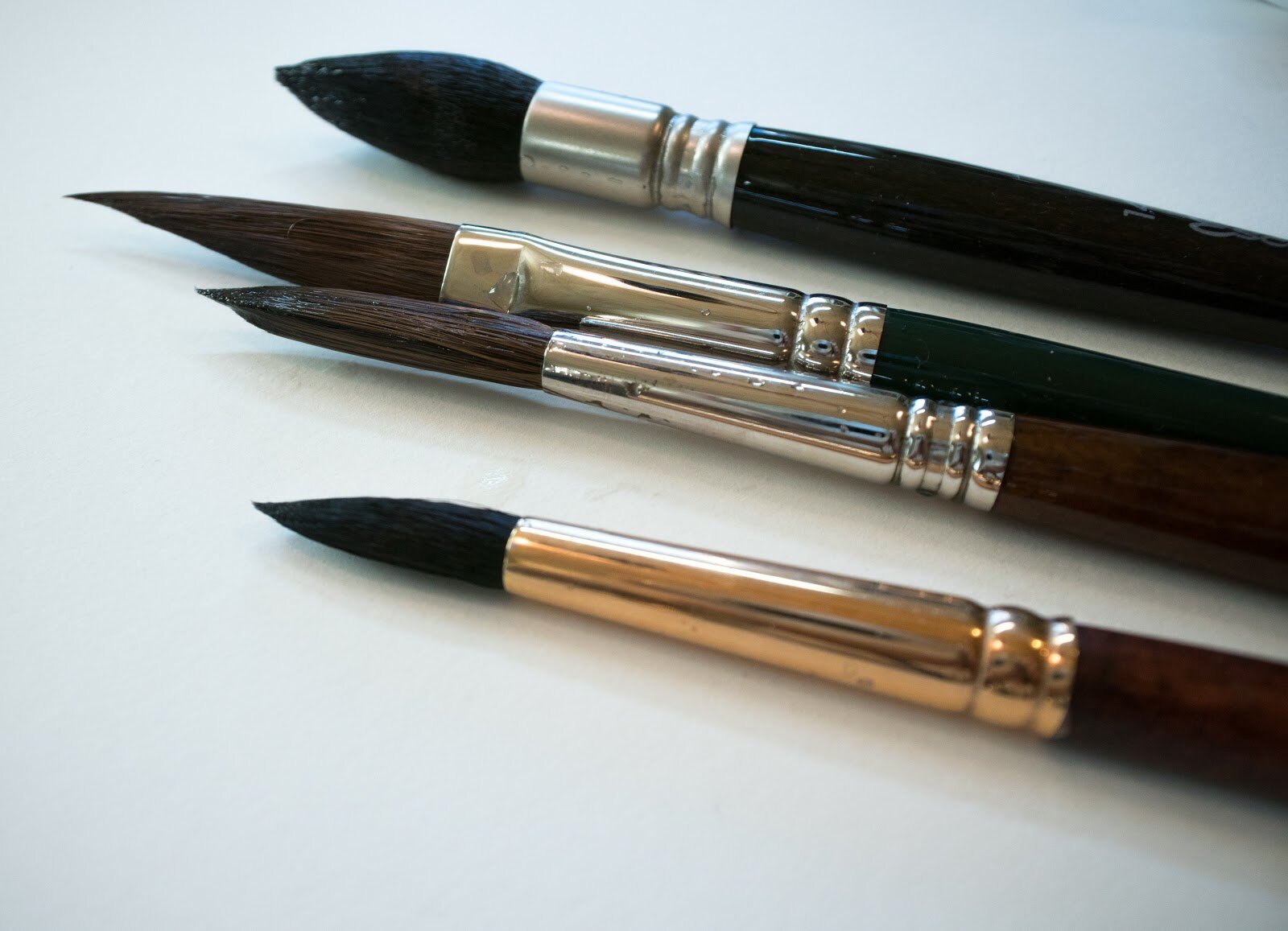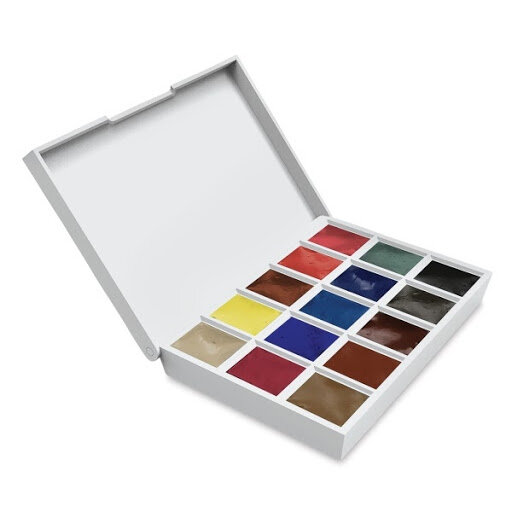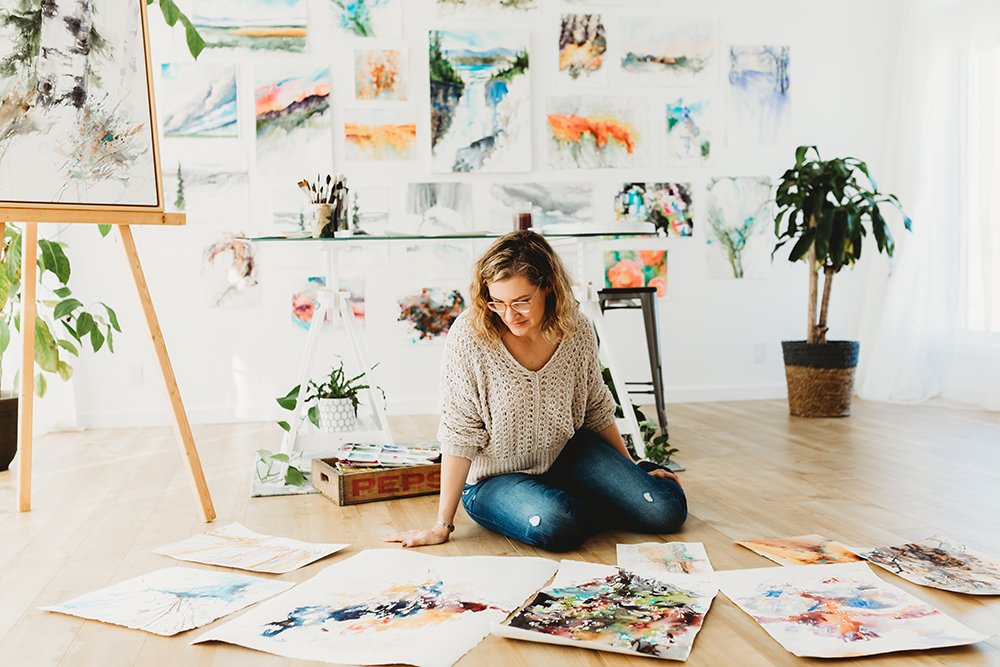Everything You Need to Know About
Watercolour Supplies
by Angela Fehr
As an Amazon Associate I earn a small commission from qualifying purchases
As a Blick Art Supplies associate I earn a small commission from qualifying purchases
Thank you!
Shopping Lists
The links below offer watercolor shopping lists from one vendor for your convenience:
Just want to go straight to buying a basic watercolor set up? THIS LINK will take you there!
Getting Started with Watercolor Materials
I think most beginning painters are overwhelmed by the prospect of choosing the right brushes, paper and paint for painting in watercolour.
I believe it’s best to keep your supplies as basic as possible in the early stages of learning to avoid being overwhelmed by choice, and even now my favorite watercolor supplies are one type of paper, two different brushes and about a dozen paint colors.
Brushes
Most new artists choose brushes that are too small. When your brush is too small, you will struggle with your washes drying before you have completely filled them with color; it takes more strokes to fill the page, and your brush doesn’t hold as much color.
I like a large round brush with a fine point. The large size (#10 or 12) holds lots of paint, while the point is capable of fine detail.
Natural hair brushes (sable or squirrel) are softer than synthetic and hold more paint and water, one reason they are preferred by professionals.
My most recommended all-around brush is the Escoda Versatil #10 rigger (third from top). It has a nice point for fine detail and holds lots of paint and water. You can fill a large area by using the side of the brush to deliver paint to the paper. (At Blick Art Materials and at Amazon.com. Outside of the USA, the best prices I have found for this brush are from Jackson’s Art.
If you’re just beginning a great brush to start with is the Princeton Neptune round #10 (bottom brush in pic above). (At Blick and at Amazon) (affiliate links).
Level Up: Want an amazing heirloom quality brush that feels like magic? I use my 1.5” goat/synthetic handmade brush from Lebenzon Painbrushes daily. Use code ANGELA when you check out for a special discount for you (affiliate link).
Paint
Choosing paint is a small part about brand, and a large part about colors. While I have over a hundred colors in my collection, I encourage new painters to start with no more than a dozen. You won’t use what you don’t know, and so working with a small range of colors gives you the opportunity to really get to know them with the goal of using them more confidently and mixing them more effectively.
There are many excellent brands. I use Daniel Smith, Rockwell, Holbein, Sennelier, M Graham, Schmincke and all are exceptional. If your budget is extremely tight, these brands offer affordable options: Shinhan PWC, American Journey (Cheap Joe’s Art Stuff)
Your Palette Should Hold a Variety of Colors:
A warm yellow: New Gamboge, Indian Yellow or Nickel Azo Yellow
A cool yellow: Hansa Yellow Light, Lemon Yellow or Benzimidazolone Yellow
A warm blue: Ultramarine Blue or Cobalt Blue
A cool blue: Phthalo Blue or Phthalo Turquoise
A warm red: Perylene Red, Pyrrol Scarlet or Quinacridone Coral
A cool red: Permanent Alizarin Crimson, Quinacridone Magenta or Quinacridone Rose
A darkest dark: Payne’s Grey or Indigo
A versatile brown: Burnt Umber
Look for colors described as “transparent” for easier mixing with less “mud.”
If you’d like to start with a set of paints, Daniel Smith’s half pan sets offer premium paint in a versatile range of colours. Order here (affiliate link). Or you can buy several years’ worth of paint by choosing tubes (tubes are more economical than pans) - I’ve listed my favorites on Blick’s site here.
Mixing Color
Please note that the cleanest, brightest colour mixes are made using the vibrant hues of magenta, cyan and yellow (think of the inks in an inkjet printer), rather than the warmer red and blue that we usually associate with the primary colour wheel.
Fun Favorites:
Opera Pink
Quinacridone Gold
Undersea Green
Cobalt Teal
Verditer Blue
Cobalt Violet
Perylene Green
Aussie Red Gold
See all of the colors on my own Daniel Smith dot card. Buy them from Blick Art Materials here.
Paper
Most new painters struggle with the idea of paying for good watercolor paper. Almost every professional artist (I can’t think of one who disagrees) will insist that paper makes a difference! More than anything else, your painting style will be dictated by what your paper is capable of. I hate seeing new painters struggle when watercolor painting is made even more difficult by cheap paper that fights the movement of the paint and water.
Avoid Wasting Money on Terrible Paper:
Tip: Learn to look at and feel what good quality paper is like so you’re not tricked by a cagey description.
Student Grade Paper: Not 100% cotton, usually has some wood pulp (cellulose) in the mix. Texture will often look regular, like a waffle or a woven fabric, and the surface will feel a bit slippery. The surface might even be a little shiny.
Pros: Affordable. Easy to find in art supply and craft stores.
Cons: Paint does not flow as readily. New layers of paint will lift/move the layers beneath. Masking fluid will often tear the paper when removed. Paper will pill more easily when trying to lift color and fix mistakes. Often single-sided (one side takes paint much better than the other).
Artist-Quality Paper: Look for descriptions like 100% cotton, mould made paper. The surface should feel rough or like peach skin. No obvious “waffle” weave in the appearance of the texture.
Pros: More durable, holds up to adding and removing masking fluid, scrubbing, lifting, layering. Fluid washes flow more beautifully. Colors appear more vibrant. Better balance between absorption and flow. Can usually paint equally well on both sides.
Cons: More expensive than student grade. Often not available outside of art supply stores.
You deserve to learn on good paper! I watch for sales and buy full sheets of paper that I can tear down to the size I want. Usually these are a better value than blocks or pads.
Paper Types:
Hot press: smoothest paper, usually used for paintings requiring fine detail and less water. Some loose painters like the watermarks hot press encourages.
Cold Press (in the UK known as NOT): textured paper, not as much texture as rough. This is the most commonly used texture for watercolour painting.
Rough: Like it sounds. Roughest textured paper.
Paper Thickness:
Paper is graded by weight. 500 sheets of 140 lb paper weighs 140 lbs. I don’t recommend buying weights lighter than 140 lb as they will buckle extensively when wet, making painting difficult.
140 lb (300 gsm) paper usually needs to be taped down to a support to help keep it flat while painting.
300 lb (600 gsm) is usually the heaviest paper you can buy, and feels like heavy card.
Paper Recommendations:
Hahnemühle: The Collection - Watercolour Paper, available in 9x12 pads and 9x12 blocks. (Available at Opus Art Supplies in Canada).
Arches sheets and Arches cold press pads, (I like the convenience of the pads but the texture is slightly different from the full sheets)
Bockingford
Fabriano (they make both student and 100% cotton paper, be careful which variety you choose!)
Indigo Art Paper: Handmade paper and more unpredictably textured. Enjoyable for loose, flowing washes.
Kilimanjaro from Cheap Joe’s Art Stuff: An economical, quality paper for US residents (shipping outside of the USA is high)
Saunders: (more common in the UK)
Winsor & Newton (they also make student grade so be careful which variety you choose!)
To stretch or not to stretch?
If you’re in discussion with watercolour artists, the topic of stretching paper is going to come up. Some artists insist that you must soak your watercolor paper, then staple it to a board and tape the edges with butcher’s tape and allow to dry to a tight surface before painting. Others, like me, never stretch their paper. My personal opinion is that stretching was used in the past to rinse off some of the sizing of the paper and prepare the surface for painting, but that modern paper doesn’t really need this treatment. Another artist says that stretching in advance is like the difference between an oil painter painting on a loose piece of canvas or a stretched one; that the tight surface is superior. You get to make up your own mind on this issue!
Other Supplies:
Basic Palette: I use this Mijello 18 well folding palette for travel (Amazon.com)
My much loved studio palette is a 64 deep-well, 18 inch diameter palette from robax.com
I also have the 12 inch, 19 well palette from Robax which I like for travel as well.
Support: I tape my paper to a corrugated plastic board. They are light, easy to cut to size, and waterproof.
Travel Palette: The Portable Painter is beautifully designed and compact for travel. Fill with your favourite colours. Use code ANGELA to save 10% on your order!
Books
I’m always learning from watercolour mentors. Some of my favourite books that I often reference in my classes can be found listed here: https://amzn.to/2FlLwID (affiliate link)
Resources to Help You Learn
While you can teach yourself to paint, sometimes the journey is just a little more efficient with a supportive instructor. I believe that you can become your own favorite artist! By developing skill in watercolor technique, you can feel free to paint expressively from your heart.
In my online classes, you will:
Learn essential watercolor techniques and when to use them in your paintings
Develop your ability to think like an artist, learning design principles so you can create strong and dynamic paintings
Grow your knowledge of color theory, value, composition, and how to use these and other foundations of art in your paintings
Learn how to simplify your paintings and learn more efficiently
Become more playful in your painting process, while still growing your skills
Learn how to draw with your brush and handle your brush more confidently
Understand common creative blocks and learn how to overcome discouragement and fear in your artistic practice.
Develop your personal style and create paintings that you absolutely love.
If you are getting started, dive into Learn Watercolour the Heart-Led Way and learn at your own pace, in your own style. No other watercolour artist teaches beginner techniques in quite this way!
I started teaching watercolor because I just couldn’t keep the exciting things I was learning about the medium to myself. I really believe that watercolor is the most beautiful medium for painting, and that everyone who wants to paint in watercolor CAN. You have what it takes to make paintings that thrill you and come straight from your heart, and I love sharing what I’ve learned over the years that makes me my own favorite artist.
Join me at learn.angelafehr.com today!
Best wishes for many wonderful watercolor adventures!
-Angela
Shopping Internationally?
Below find some links to suppliers in Canada, Europe & Australia
The links below are not exhaustive. If you have a supplier you’d love to recommend, email me!
Canada:
Delta Art, Edmonton, Alberta
Opus Art Supplies, British Columbia
Curry’s Art Supplies, Ontario
Studio Six, Ontario
Above Ground Art Supplies, Toronto
Kings Framing and Art Gallery in Corbeil, Ontario
Endeavors in Fredericton, New Brunswick
Gwartzman’s Art Supplies in Toronto, Ontario







